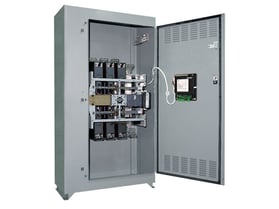
When the power goes out, time is of the essence. It’s up to the transfer switch – whether physically operated (manual switch) or automatically triggered (automatic switch) – to quickly transfer the electrical load from the affected primary power source to the Emergency Power Supply (EPS).
Chapter 6 of the National Fire Protection Association Standard 110 (NFPA 110) is devoted to the transfer switch. For most applications where NFPA 110 would apply, an automatic transfer switch (ATS) is used to transfer load to the EPS during a power outage – and back again, once power returns.
NFPA 110 Chapter 6 requires that:
- Each switch is listed for emergency service as a completely factory-assembled and factory-tested apparatus. (6.1.6).
- Mechanical interlocking, or an approved alternate method, is used to prevent the inadvertent interconnection of the primary power supply and the EPS, or any two separate sources of power. (6.2.3)
- Transfer switches be equipped with time-delay devices, engine generator exercising timers, a test switch, and other controls and indicators to allow safe and reliable operation. (6.2).
- When two or more generators are paralleled for emergency power, the paralleled system must be arranged to prevent the connection EPS-damaging loads. (6.3)
- Overcurrent protective devices (OCPDs), including circuit breakers and fuses, are coordinated to optimize selective tripping when the short circuit occurs (6.5).
Section 6.3.3 requires that the transfer of loads shall be sequenced as follows:
- First priority loads, such as emergency loads, shall be switched to the emergency bus upon sensing the availability of emergency power on the bus (within 10 seconds)
- Legally required standby loads follow the emergency loads (within 60 seconds)
- Last priority are the optional standby loads
Each time an additional generator set is connected to the bus, a remaining load shall be connected in order of priority until all standby loads are connected to the bus. Should one or more engine generator sets fail, the system must automatically reduce (or shed), starting with the least priority load, to preserve the highest priority or emergency load.
Included in nearly all power generation applications, there are a variety of rugged and reliable transfer switch solutions available to transfer critical loads when normal utility power fails.
Download your nfpa110 forms here!
For more information about transfer switches, read our NFPA 110 Chapter 6 web page and browse our technical articles. Or contact us for experts to guide the design, installation, operation, testing and maintenance of your power generation system.
.png?width=159&height=72&name=Curtis%20Power%20Solutions%20(RGB).png)






